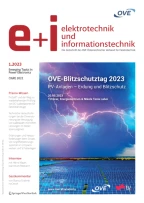Abstract
Due to today´s increased demands on grid operation management, new methods for earth fault localization and detection are needed. The fault localization should be performed as quickly as possible and under the condition, that the fault current at the fault location will not be significantly increased.
The pros and cons of Distance Protection in solid grounded networks are well known. In case of a single-line earthfault, the current via the fault location in solid grounded networks is in the range of some kA. In compensated networks the residual current \(I_{\mathrm{res}}\) via the fault location is, in case of a single line fault, only few ampere. Very often this current is much smaller than the load current of the feeder. A distinction between load current, circulating currents in meshed networks and fault current is more or less not possible. Therefore, the Earthfault-Distance-Protection in compensated networks is usually switched off.
With the new transient relays, based on the qu2-algorithm, it is possible to detect in the substation very reliable the faulty feeder and the direction of the fault. This statement is also correct for meshed networks. In a 110-kV-network the distance between two substations is in the range of 50 km to 200 km. Also if the feeder is identified correctly, it is still a challenge to locate the exact fault position on this feeder.
The results of field-test in a 110-kV-network with different fault impedances will be presented.
Similar content being viewed by others
References
Aichhorn, A., Etzlinger, B., Mayrhofer, R., Springer, A. (2016): Accurate clock synchronization for power systems protection devices over packet switched networks. Comput. Sci. Res. Dev., 32(1–2), 147,–158. 2017.
Achleitner, G. (2008): Earth fault distance protection. Dissertation, Technische Universtität Graz.
Achleitner, G., Leitner, W., Druml, G., Simon, R., Fickert, L. (2017): 110-kV-Erdschlussversuch und Test eines Erdschlussdistanzschutzes. In Proccedings ETG Fachtagung STE 2017 Aschaffenburg. ETG-Fachbericht (Vol. 151). Berlin: VDE-Verlag.
Druml, G. (2013): Innovative Methoden zur Erdschlussortung und Petersen-Spulen Regelung. Thesis, Institute of Electrical Power System in Graz, Austria.
Druml, G., Schmidt, U., Schegner, P. (2016): Effects of the nonlinear Arc of a 20-kV-net single-line cable fault on the earth-fault-detection and control. In Conference PAC world 2016, Ljubljana, Slovenia.
Druml, G., Seifert, O., Zickler, U., Roser, M., Fickert, L. (2011): Auswertung von nichtlinearen Erdschlüssen. In Proccedings ETG Fachtagung STE 2011 Erfurt. ETG-Fachbericht (Vol. 129). Berlin: VDE-Verlag.
Druml, G., Skrbinjek, O., Hipp, W., Aichhorn, A., Schmidt, U., Schegner, P. (2017): Abschätzung der Fehlerentfernung von Erdschlüssen basierend auf Wanderwellen. In Proccedings ETG Fachtagung STE 2017 Aschaffenburg. ETG-Fachbericht (Vol. 151). Berlin: VDE-Verlag.
Herold, G. (2008): Elektrische Energieversorgung II. Weil der Stadt: Schlembach Fachverlag.
Imriš, P. (2008): Transient based earth fault localisation in 110 kV subtransmission networks. TKK dissertation, Espoo, Finland.
Küchler, A. (2009): Hochspannungstechnik, Grundlagen-Technologie-Anwendungen. 3rd. ed. Berlin: Springer.
Melzer, H. (2012): Die aktuelle Situation der Sternpunktbehandlung in Netzen bis 110 kV (D-A-CH). In ETG-Fachbericht (Vol. 132). Berlin: VDE. 2012.
Tengg, Ch., Schoass, K., Druml, G., Schmaranz, R., Marketz, M., Fickert, L. (2013): Evaluation of new earth fault localization methods by earth fault experiments. In CIRED Stockholm (p. 1317).
Wurm, M. (2013): Vergleich der Bestimmungsmethoden der Fehlerortentfernung beim einpoligen Fehler und Nachweis im praktischen Netzbetrieb. Dissertation, Technische Universtität Graz.
Author information
Authors and Affiliations
Corresponding author
Additional information
Paper submitted for the CIGRE Session 2018, SC B5, Paris, France, August 26–31, 2018
Rights and permissions
About this article
Cite this article
Druml, G., Achleitner, G., Leitner, W. et al. New single-ended earthfault distance estimation for the 110-kV- and 20-kV-compensated network. Elektrotech. Inftech. 135, 567–575 (2018). https://doi.org/10.1007/s00502-018-0663-y
Published:
Issue Date:
DOI: https://doi.org/10.1007/s00502-018-0663-y
